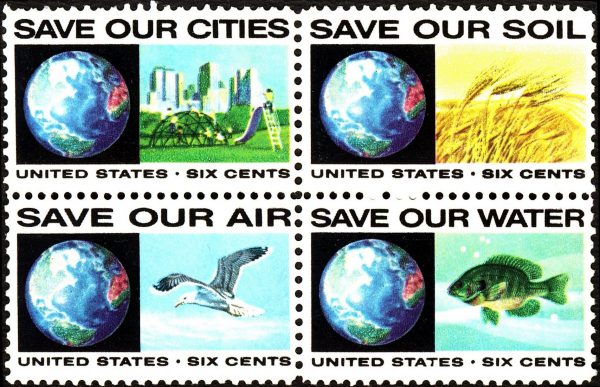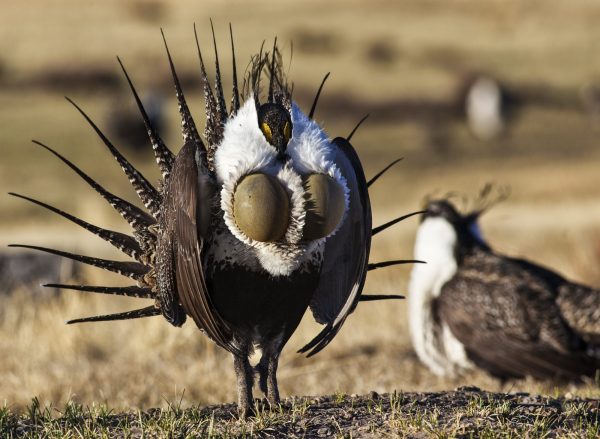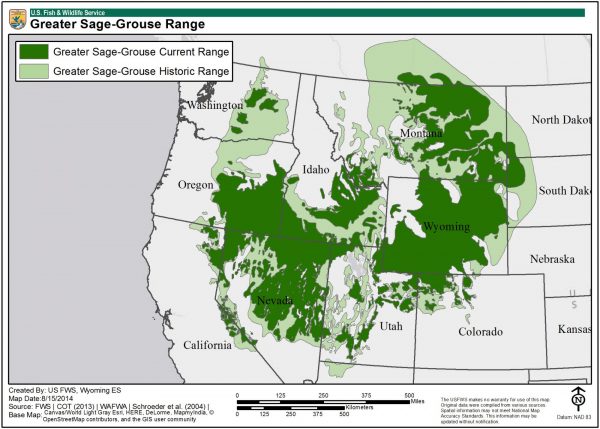The Endangered Species Act
On Friday September 25, 2019 Colorado and 16 other states sued Republican president Trump’s administration. They were attempting to block pushbacks to the Endangered Species Act (ESA). Today the ESA is politically controversial. However, in 1973, Republican president, Richard Nixon, signed the law with bipartisan support.[1] Throughout the 1970s, bipartisan support remained consistent. Beginning in the 1980s with the Reagan administration, the act’s bipartisanship unraveled. Placing the newest round of changes to the act into historic context reveals that presidents of both political parties have advanced and rolled back ESA protections over the past sixty years, shaping the Act to serve their political moments.

Photo courtesy of US Postal Service, https://en.wikipedia.org/wiki/File:Usstamp-save-our.jpg
A Bipartisan Era: 1960s-Early 1970s
In the 1960s and 1970s the United States was in the middle of the modern environmental movement. During this time environmentalism was not a right wing problem or a left wing problem. Instead, the majority of Americans saw protecting the planet as a political priority.[2] Even postage stamps reflected the era’s environmentalist ethic.
The fight for environmental conservation led to a variety of legislation being passed in the 1970s. These included the National Environmental Protection Act (NEPA) and the Clean Water Act.[3] Species conservation was also a priority. Democratic president Lyndon B. Johnson signed the Endangered Species Preservation Act of 1966. This act gave endangered species native to the U.S. limited protections. Then, Republican Richard Nixon signed the Endangered Species Conservation Act of 1969. The law prohibited selling or importing endangered species in the U.S. and allowed amphibians and mollusks to be classified as endangered.[4] Finally, on December 28, 1973, Nixon also signed the Endangered Species Act.
Even more than previous laws, the ESA improved species’ chances of survival. It required a recovery plan and habitat protection for endangered animals. During Democrat Jimmy Carter’s administration, Congress further strengthened the Endangered Species Act. It defined critical habitat as “any part of the landscape essential to the conservation of a species.”[5] The definition of critical habitat is what has made the Endangered Species Act so successful.[6]
Growing Divides: Late 1970s to Early 2000s
In the late 1970s and early 1980s, the U.S. economy faltered. Oil shortages, inflation, unemployment, and sinking wages changed Americans’ political priorities. These factors ultimately led to an economic recession from 1981-1982.[7] Economic crises stalled the environmental movement, forcing it out of the political limelight.
President Ronald Reagan’s emphasis on economic advancement rather than the conservation of the environment reflected this change.[8] In addition, the environmental protections of the 1970s were victims of their own successes. Improved environmental conditions contributed to changes in the public’s focus. In 1982 Congress passed amendments that weakened the Act. Among other things, the amendments made it easier for non-federal land managers to gain permission to harm protected species.[9] In 1988, Congress made more amendments requiring federal agencies to notify the public about recovery plans and allow public comment on them. [10] Federal agencies needed to consider and review these comments. This benefited industry representatives, and provided opportunities to block critical habitat designation.
In the 1990s the Endangered Species Act stagnated. Neither Republican president George H.W. Bush nor Democratic president Bill Clinton made significant changes.[11] The next step back for the Endangered Species Act came under Republican George W. Bush’s administration in 2004. Congress exempted the Department of Defense from designating critical habitats for endangered or threatened species on military land.[12]


The Greater Sage Grouse and Partisanship: 2010s to Present
In the West, endangered species like the greater sage-grouse suffered from weakening protections and erratic conservation policy. Conservationists have pushed for the bird to be listed as an endangered species to protect its habitat. That designation would disrupt some of the West’s most profitable industries including grazing and energy development on 173 million acres of public, state and private land in the West.[13]
In 2015, the Obama Administration created a compromise that limited development and restored areas of core sagebrush habitat for the greater sage-grouse.[14] That compromise was short-lived. Soon after, the Trump Administration abandoned the compromise and again allowed oil and gas development on millions of acres of grouse habitat.[15] The bird is not currently listed as an endangered or threatened species. It is unlikely that the bird and its habitat will receive the protection they need under the act’s current form.

Photo courtesy of Maxpixel, https://www.maxpixel.net/Environmental-Activist-London-Demo-Demonstration-4193109
A Future for the Endangered Species Act
In response to the recent changes to the Endangered Species Act, 17 states came together to file a lawsuit against the U.S. Department of Interior and Department of Commerce.[16] The states involved are largely Democratic-leaning. Their lawsuit underscores the partisanship surrounding species conservation in the current political climate.
If successful, the lawsuit will ensure that the Endangered Species Act will only examine the best scientific data available when protecting endangered or threatened species and their habitat, rather than factoring in the economic cost of protecting endangered species and the land they need. Despite widespread public support, species conservation needs sustained effort to protect endangered animals over the long term. This can only be done by recovering a broad, apolitical consensus around species conservation.
-Hailey Doucette, PLHC Intern
Published 11/15/19
Sources
[1] Jeremy Bruskotter, John Vucetich, and Ramiro Berado, “Support for the Endangered Species Act Remains High as Trump Administration and Congress try to Gut it,” July 21, 2019, Accessed November 5, 2019, https://www.pbs.org/newshour/science/support-for-the-endangered-species-act-remains-high-as-trump-administration-and-congress-try-to-gut-it
[2] Jaime Fuller, “Environmental Policy is Partisan. It Wasn’t Always,” The Washington Post, June 2, 2014, Accessed October 8, 2019, https://www.washingtonpost.com/news/the-fix/wp/2014/06/02/support-for-the-clean-air-act-has-changed-a-lot-since-1970/
[3] Roy Beck and Leon Kolankiewicz, “The Environmental Movement’s Retreat from Advocating U.S. Population Stabilization (1970-1998): A First Draft of History,” Journal of Political History, vol. 12 no. 1, (2000), p. 123-124
[4] Melr, Rlnde, “Richard Nixon and the Rise of American Environmentalism,” Distillations, June 2, 2017, Accessed November 11, 2019, https://www.sciencehistory.org/distillations/magazine/richard-nixon-and-the-rise-of-american-environmentalism
[5] Toy, Davis. “Critical Habitat: The Inside Story,” High Country News, February 20, 2006, Accessed November 5, 2019, https://www.hcn.org/issues/316/16119
[6] Zack Strong, “Critical Habitat: The Next Endangered Species,” Natural Resources Defense Council, September 25, 2019, Accessed November 11, 2019, https://www.nrdc.org/experts/zack-strong/critical-habitat-next-endangered-species
[7] Joseph Locke and Ben Wright, The American YAWP, (Stanford University Press, 2019), 29.
[8] Lou, Cannon, “Ronald Reagan Campaigns and Election,” University of Virginia Miller Center, Accessed October 7, 2019, https://millercenter.org/president/reagan/campaigns-and-elections
[9] Chris, Clarke, “The Endangered Species Act 40 Years of Compromise,” Public Media Groups of Southern California, January 24, 2014, Accessed October 7, 2019, https://www.kcet.org/redefine/the-endangered-species-act-40-years-of-compromise
[10] Nicole, Rosmarino. “Endangered Species Act Under Fire; Controversies, Science, Values, and the Law.” PhD. Diss., University of Colorado, 2002, pg. 338-339. http://wg.convio.net/support_docs/ESA-under-fire-controversies-science-values-law_4-29-02.pdf http://wg.convio.net/support_docs/ESA-under-fire-controversies-science-values-law_4-29-02.pdf
[11] Marshall Shepard, “The Surprising Climate and Environmental Legacy of President George H.W. Bush,” Forbes, December 1, 2018, Accessed October 8, 2019, https://www.forbes.com/sites/marshallshepherd/2018/12/01/the-surprising-climate-and-environmental-legacy-of-president-george-h-w-bush/#3374db83589c
[12] “The Endangered Species Act at 40,” Endangered Species Coalition,” Accessed October 7, 2019, https://www.endangered.org/campaigns/esa-at-40/
[13] Hannah Nordhaus, “An Important Bird Lost Habitat Protections; Here’s what it means,” National Geographic, March 21, 2019, Accessed October 23, 2019, https://www.nationalgeographic.com/environment/2019/03/sage-grouse-rule-rollback-conservation/#close
[14] Francie Diep, “Protected Under Obama the Greater Sage Grouse Finds itself once again under threat,” Pacific Standard, August 8, 2017, Accessed October 23, 2019 https://psmag.com/environment/sage-grouse-finds-itself-once-again-under-threat
[15] Jimmy Tobias, “Compromise with Oil and Gas Industry Made the Sage Grouse Vulnerable to Extinction,” Pacific Standard, March 26, 2019, Accessed October 23, 2019, https://psmag.com/environment/compromise-with-the-oil-and-gas-industry-made-the-sage-grouse-vulnerable-to-extinction
[16] Green, Miranda, “17 States Sue Trump Administration Over Weakening of Endangered Species Act,” September 25, 2019, Accessed October 9, 2019, https://thehill.com/policy/energy-environment/463046-17-states-sue-trump-administration-over-weakening-of-endangered